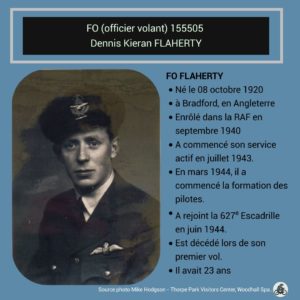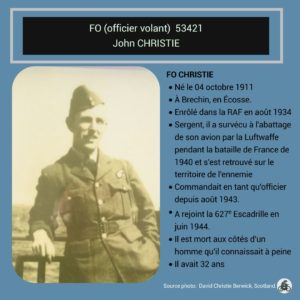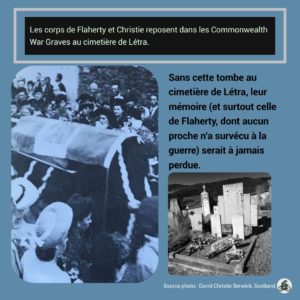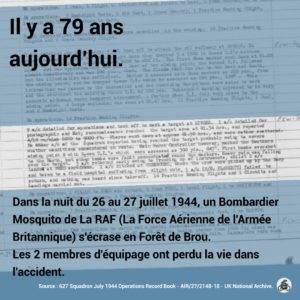79th Anniversary and Worthy of a Quick Reminder.
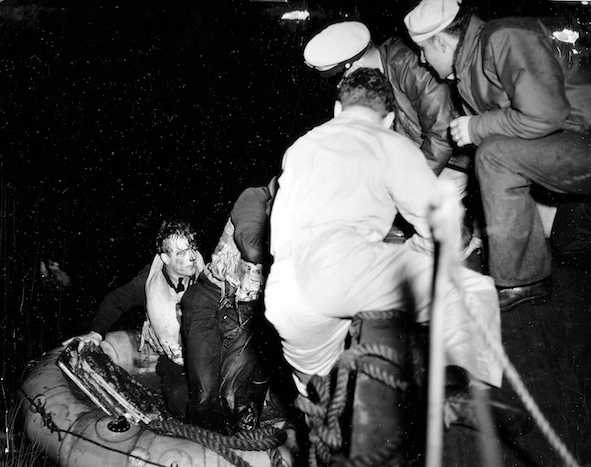
On 6th June 1944, troops from the UK, France, USA and Canada attacked German forces on the coast of Northern France. A vast military operation involving military resources on air, land and sea marked the start of the campaign to liberate Nazi-occupied North-West Europe.
At 21:20 hrs on the evening of 26th July 1944, 178 Lancaster Bombers left various English airfields; their mission was to destroy the marshalling yard at Givors. The 9 De Haviland Mosquitos pathfinders who were to accompany the Lancasters were from 627 Squadron, RAF Woodhall Spa, an airfield in the East of England in the county of Lincolnshire.
The de Havilland DH.98 Mosquito was a British twin-engined, multi-role combat aircraft operated by two crew members. It was built mainly of wood – because wood was the only freely available material, hence its nickname of the Wooden Wonder. It was one of the world’s fastest operational aircraft and so took off around 2 hours after the Lancasters to RV over Lyon.
The Pathfinder’s role was to deploy markers across the marshalling yard at Givors to assist in accurately placing the payload from the heavy bombers. Givors had been the target of numerous bombing raids during World War II by the Luftwaffe, RAF and USAF. Since D-Day, once again, marshalling yards across France had become the focus of intense bombing raids to thwart the movement of reserves and military cargo across Europe by the German Army. The use of Pathfinders was designed to reduce civilian casualties by increasing accuracy.
However, overnight, 26th – 27th July 1944, there was a massive storm across Europe, and the enormous airborne bomber force would be flying into the storm to drop their deadly cargo. While the weather ensured that few German Forces would be airborne across the target, the bomber formation was intercepted en route in the north by JU88’s and ME410’s. Despite the near-zero visibility, heavy rain and continuous thunder, the strategic imperative of the mission meant that cancelling the operation for any reason was not an option available to the allies.
It was less than three weeks since the invasion, and there was still fierce fighting in the north of France. The bomber force was required to undertake a circuitous route to their objective to avoid being targeted by friendly forces – a prospect exacerbated by the horrendous weather. Their path took them southwest down the English Channel, crossing the French coast into Bretagne and then dropping down to approach Givors from the west. The tortuous nature of the route and the weather put the Mosquitoes at the limit of their range.
Of the nine de Haviland Mosquito’s, only 3 made it to the target. The Squadron record for the night states:
“9 aircraft detailed for operations and took off to mark a target at GIVORS. One aircraft detailed for photographic and Met (Weather); reconnaissance reached the target area at 01:34hrs … Flares went down at approximately 01:50 hrs and were rather scattered…“
The Operations Record Book provides more detail, proving that three aircraft did indeed manage to reach the target, but the markers they dropped were very scattered and inaccurate. Upon return, one of those ran short of fuel and ended up ditching in the Channel and was picked up by the Navy. Of those that never arrived, one could not identify the target, and four had to abort and return early because of ice forming on the wings.
DZ636 was designated as MARKER N°3 – The operations logbook names the two-person crew and that it failed to return.
Operation Record Book

We now know that this aircraft crashed in the Foret du Brou above Ternand that night, killing Pilot and Navigator.
It is impossible to be 100 per cent certain as to the cause of the crash.
DZ636 did not make it to the target area. There is witness testimony to say that it had no bomb payload. However, the payload was not traditional explosives, but flares, and so to an untrained eye could have been missed.
There are potentially several contributory factors that resulted in the crash.
Firstly the weather, as I have mentioned above, there was a massive electrical storm across Europe, which ended a prolonged heatwave. Such a storm caused icing on the wings, disorientation due to the effect of the navigation equipment and undoubtedly contributed to the operational logbook entry:
“Target as above (Givors). This aircraft failed to return; Nothing heard since take off.”
Flight Record Book
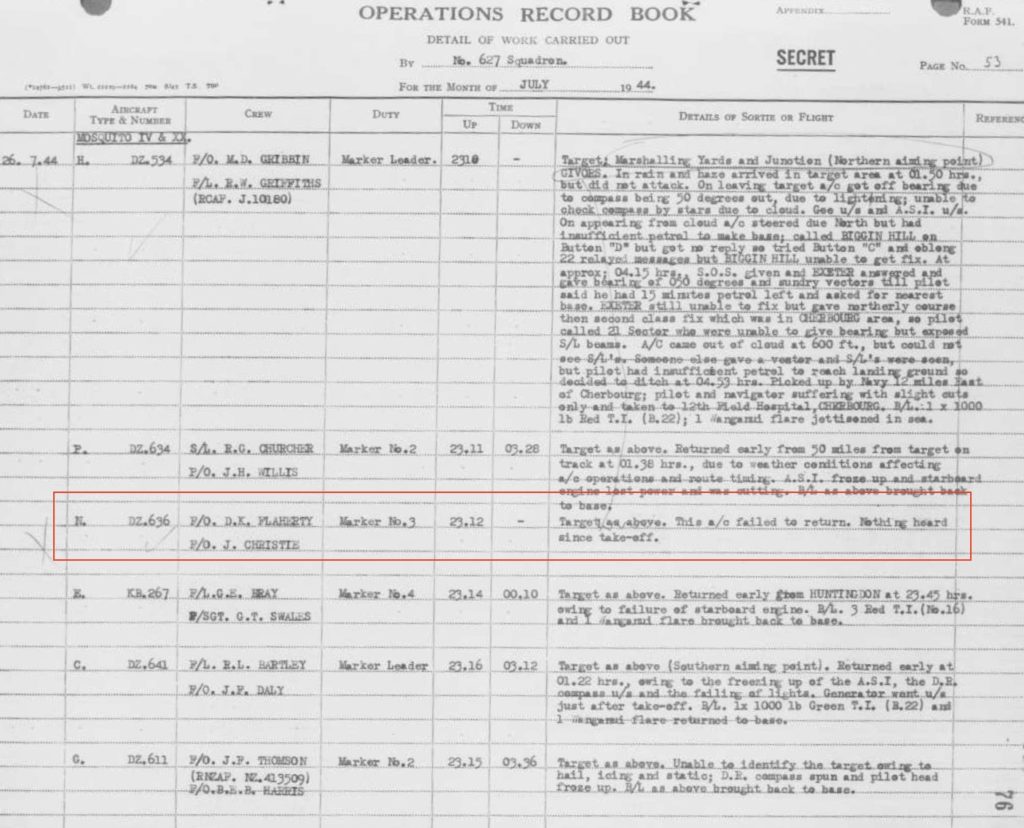
Secondly, the inexperience of the Pilot.
There were two members of the crew; the navigator was John CHRISTIE. He was born in October 1911 in Brechin in Scotland. He enlisted in the RAF in August 1934 at age 23. He worked his way up and was a flight sergeant when war broke out. He was stationed in Poix en Picardie with 53 squadron. He was an observer in Blenheim Bombers during the battle of France engaged in reconnaissance duties as the Germans advanced on France. He worked with the same crew for 18 months. Flying Officer Alaistair Panton was the Pilot, and the gunner was and Gunner AC2 Bence. On 11th May 1940, they were shot down behind enemy lines in Belgium. Badly injured, Christie managed to get himself back to the UK in what can only be described as a fantastic feat of bravery and cunning. Panton returned to flying and later that year was captured by the Germans. He spent the rest of the war as a Prisoner and, after staying in the RAF in a career lasting 35 years, rose to the rank of Air Commodore. AC2 Bence lost his leg and was arrested in a French Hospital. In later life, he became a school headmaster in Gloucestershire.
CHRISTIE was commission in August 1943 and made a Flying Officer, and posted to 627 squadron on Mosquitos in June 1944. He was an experienced officer, and as is often the case, he would have been buddied up with a less experienced officer for operations.
John CHRISTIE FO RAF
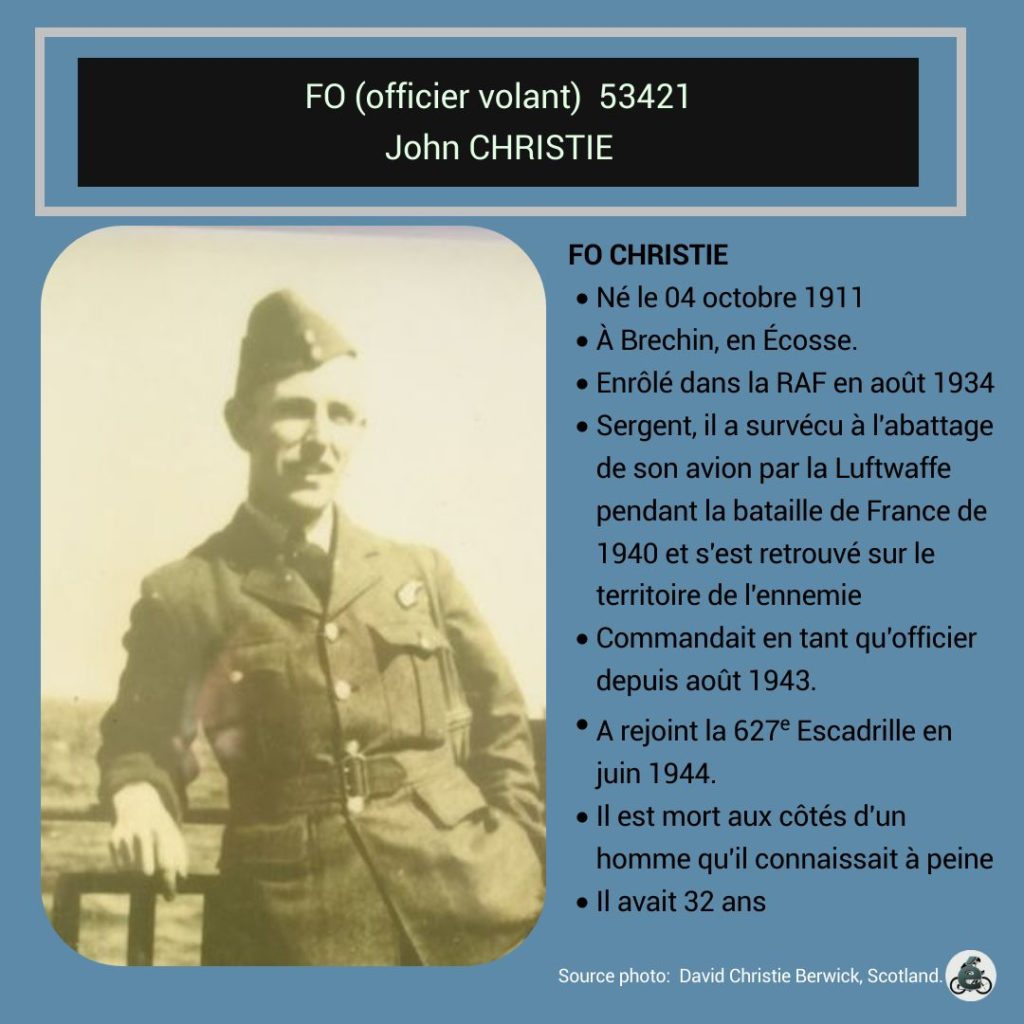
On the night of 26th July 1944 – the less experienced officer was his Pilot, Flying Office Dennis Kieran FLAHERTY, born 8th October 1920 in Bradford in the North of England. He was an only child. He enlisted in September 1940 and was commissioned in July 1943. His career as a Pilot started with initial flight training in March 1944. After he trained to fly Mosquitos and was posted to Operational Aircrew with 627 squadron in June 1944 – he survived just 51 days.
FO Dennis K Flaherty
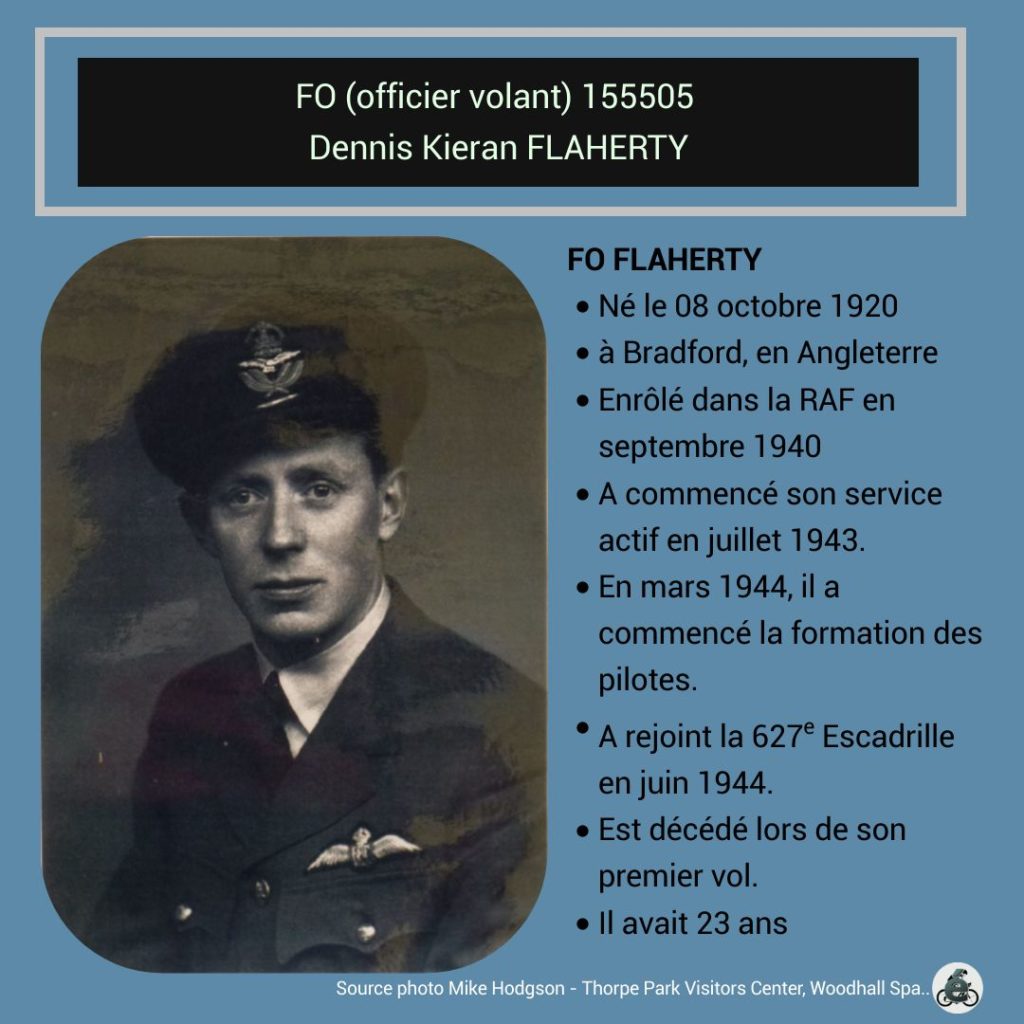
The last factor is perhaps the most subjective. I have no evidence, but it seems to fit. Ian Stevenson carried out an investigation into 2 Lancaster bombers from the same raid on Givors that crashed near St IGNAT near to Clemont-Ferrand. He details how the weather, route and sheer volume of aircraft involved in the operation resulted in several mid-air collisions. It is not beyond the realms of possibility that the Mosquito DZ636 had been involved in a mid-air collision which contributed to the Pilot losing control and crashing.
As to the exact details of why or how the crew of the Mosquito DZ636 lost their lives – one can only surmise.
There was, without doubt, a ferocious storm across large swaths of Europe that night, bringing the heatwave to a close.
Other Mosquitos of the squadron had experienced problems of wings icing, engines icing and other catastrophic failures resulting from the storm, including disorientation through the instrument failure.
There is no suggestion that DZ636 was shot down; it was more likely due to icing, inability to navigate, direct lightning hit, or even a mid-air collision.
Whatever happened, these two flying officers indeed lost all contact very early in the mission. Notwithstanding this, they continued that mission despite being what one Pilot who survived the operation described as one of the most tiring and exacting eight-hour flights ever. Without a doubt, Flying Officers Flaherty and Christie died hero’s, alone on a lonely hillside and in death, by the inhabitants of Letra and the surrounding area, were treated with respect and dignity and will always be remembered.
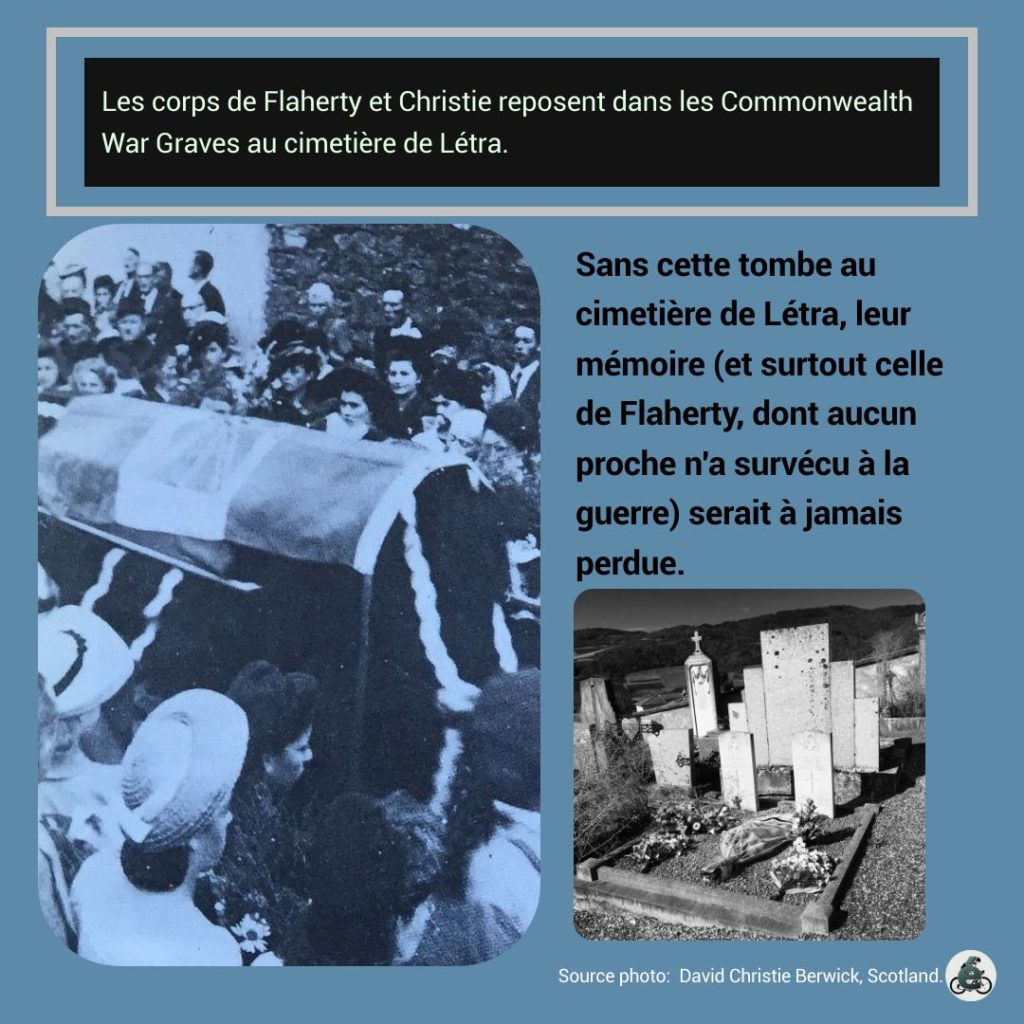
In July 2018, I visited Thorpe Camp, the base of 627 Squadron in Woodhall Spa. It is now a privately owned museum. On the wall, I found a photograph of Flying Office Dennis Kieran FLAHERTY. I was delighted; I had begun to think that no photo existed. Mike Hodgson, the founder of the Thorpe Camp Visitors Centre, told me that after the war, the survivors of 627 Squadron would meet for a reunion once a year. Initially, there were many pilots, navigators, ground crew, WAAFS (Women’s Auxiliary Air Force ), and their wives and partners. Slowly over the years, the numbers dwindled. Today there are no reunions.
“Every reunion, they would often look at this picture,” said Mike Hodgson,” but not one of them ever recognised him.”
Flying Office Dennis Kieran FLAHERTY’s life as an operational pilot in the RAF was so short – no one even remembered him.
One million men and women served in the Royal Airforce with volunteers from all over the British Commonwealth, Eastern Europe, France and even Germany.
Of the 125,000 aircrew, 72% were either killed, seriously injured or taken prisoner.
44% were killed – the highest rate of attrition of any allied unit.
For all these reasons, I so greatly admire what happened in the aftermath of the deaths of Christie and Flaherty; the contribution of the local community to preserving their memory can not be overstated.
Without that grave, the memory of Flaherty in particular, who has no surviving relatives, would be lost forever. This is why I try to help the International Bomber Command Centre in Lincolnshire, England, continue its work Recognising, Remembering and Reconciling the work of the brave men and women who gave so much to ensure we have the freedoms that we enjoy today.
Graves Registration Report – 21 Dec 1959
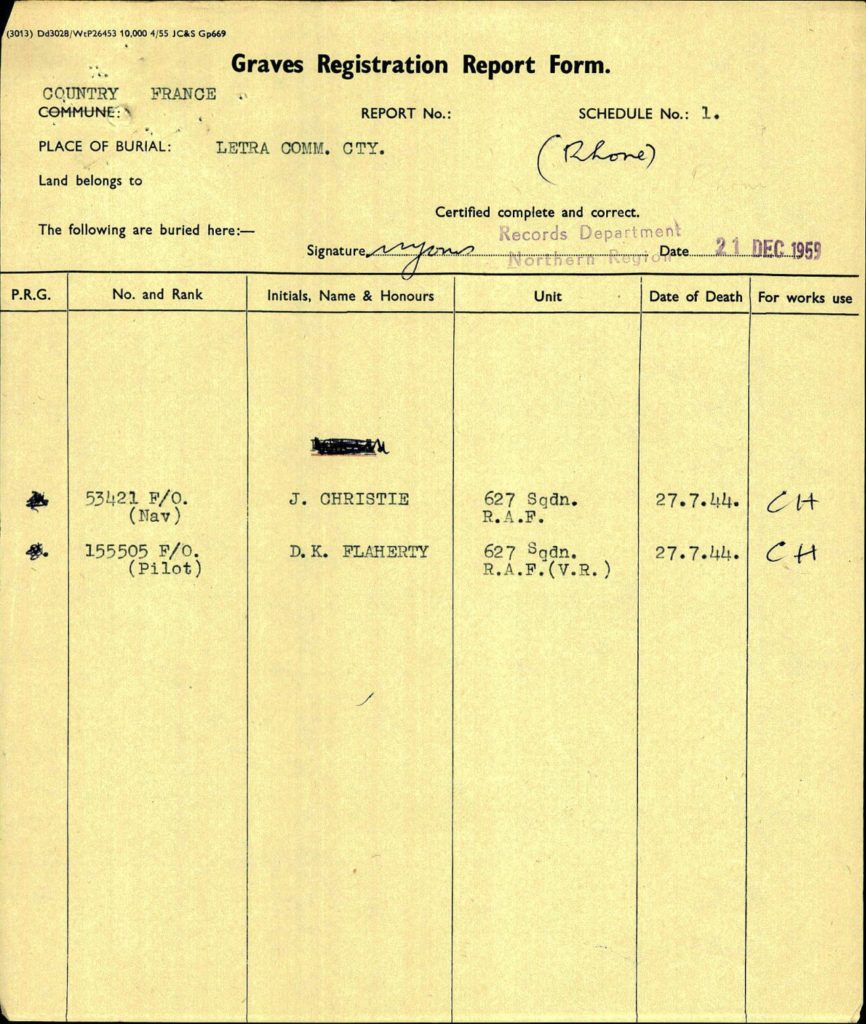
From ÉCRIVÉLO Social Media
SOURCES and Links
No part of this work may be reproduced, stored or transmitted, in any form or by any means whatsoever, without the prior written permission of the author, nor otherwise circulated in any other format or cover than the present ones.
All photographs used must contain in the caption all descriptive details as provided in the appendix and details of their source and attributions.
The moral rights of the author are guaranteed.
-
FO Dennis K Flaherty.JPG (Pilote du DZ 534 – Dennis K Flaherty) SOURCE: Photo © THORPE PARK VISITORS CENTRE, Woodhall Spa Lincolnshire. (Use of photo permitted by Martin Baker.)
Funeral of FLARTY and CHRISTIE.jpg ( Funérailles de FLARTY et CHRISTIE) SOURCE : Photo property of and © David CHRISTIE (Nephew of John Christie – Use of photo permitted by Martin Baker.)
Graves Registration Report – 21 Dec 1959.JPG – ( Rapport d’enregistrement des tombes – 21 décembre 1959) SOURCE : Review of burial site of CHRISTIE and FLAHERTY in LETRA ©Commonwealth War Graves Commission.
Highlighted Flight Record Book.jpeg ( Carnet de vol en surbrillance – Affichage des détails du vol de Mosquito DZ 534) SOURCE : © United Kingdom National Archives
Highlighted Operation Record Book.jpeg ( Highlighted Operation Record Book.jpeg – Affichage des détails de l’opération de l’escadron) SOURCE : © United Kingdom National Archives
John CHRISTIE FO RAF. JPG ( Photographie du navigateur du Mosquito DZ 534) SOURCE: Photo de famille appartenant à David CHRISTIE – Neveu de John – Copie également fournie par David CHRISTIE au Maire de Létra)
- J M Sonnery – Mémorial à Sébastien Jean-Marie SONNERY au cimetière de Chamelet.

